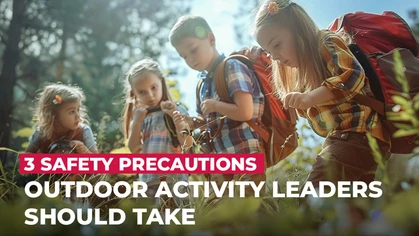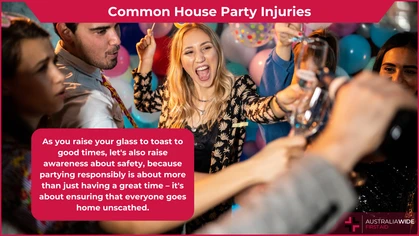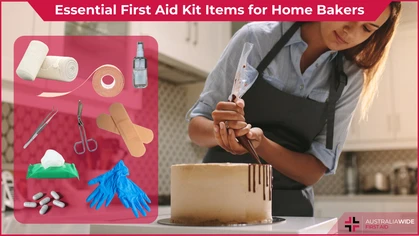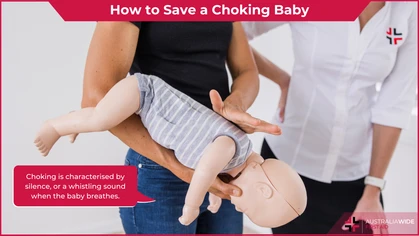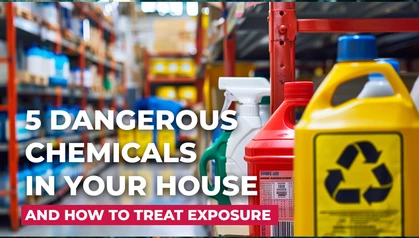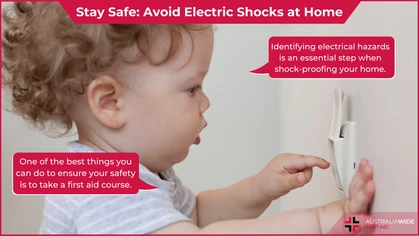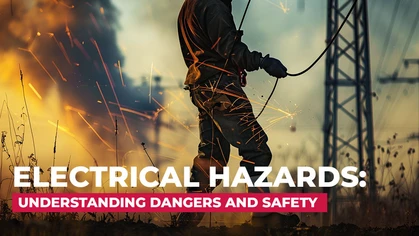A Guide to Safer Hiking in Australia

Danger

Australians, possibly more than anyone, appreciate the value of first aid know-how in remote areas.
"In Australia, everything is out to kill you." Hearing this may come with a hint of pride, and with more than a hint of truth, too. Certainly from a first aid perspective, Australia can be a dangerous place, and outdoor adventuring in Australia can present some serious safety concerns. Take for example, a 5-hour period in 2016 that 4 Victorians failed to survive. The fatal hand was dealt by a thunderstorm, which resulted in severe allergic reactions and asthma attacks that prompted almost 2000 ambulance calls. We refer to this article as a reality check to help ensure that your adventures in the Great Outdoors don’t go pear-shaped in a hurry.See the Great Outdoors and Live to Tell the Tale
Being mindful is key. When you go to gather around the campfire, be careful where you sit. And when you finally decide to jump into your sleeping bag, make sure that no nasty critters will be cuddling up next to you. If you fancy a morning surf, check for rips. And fins. Don’t forget the sunscreen and the bug spray. Stay hydrated. First aid? Knowing it goes without saying. Possibly more than anyone, Australians appreciate the value of first aid know-how in remote areas. Being mindful is key to staying safe in the Great Outdoors. Take care.Don’t Panic. Let’s Look at the Figures.
A study in 2017 looked into the coronial data between 2000 and 2013, when almost 42,000 Australians found themselves in hospital after being bitten and/or stung. Spiders (30%) and snakes (15%) accounted for their share of mayhem; however, almost 33% of hospital admissions involved stings from bees, wasps, and hornets. It turns out that the stings from bees and wasps are just as deadly as bites from snakes. Between 2000 and 2013, snakes killed 27 Australians, with bees and wasps accounting for an equal number. Australian spiders, despite their ominous and well-deserved reputation, were not to blame for a single fatality from 2000 to 2013. That said, during that same period, they did send close to 12,000 people to hospital. A bite from a Redback spider caused the last documented death from a spider in Australia in 1999. Crocodiles killed 19 people between 2000 and 2013, and sharks took 26. First past the post in terms of animal-related causes of death, however, was a less likely suspect: the horse. In the study period, 74 Australians were thrown or trampled to death by horses. Man’s best friend, the dog, caused 23 fatalities. During the same study period, nearly 5,000 people drowned. Let that sink in (pardon the pun) — Sharks: 26; Drowning: 5,000.Prepare to Hike
Now, let’s get back to the topic we started with — Hiking. It sounds perfectly straightforward. Pack your gear. Drive to your national park of choice. Follow the trail. But even a hike planned by seasoned outdoorsy types is not without its risks. There are often scrapes and always insects. There’s sunburn. There are snakes and spiders. And too often, there’s anaphylactic shock. Hiking is also physically demanding. Your body needs to be prepared for shock, strain, and fatigue on the trail. If you’re underdone, anything from severe cramps to a heart attack could result. In the latter case, first aid had better be handy. Cardiac arrest is a leading cause of death in the Great Outdoors. If you know you’re at risk, you’d be wise to seek approval from your doctor before you go on a hike. It’s not just your body that needs to be prepared. Being prepared also includes painkillers. In fact your emergency first aid kit should also include bandages, ointments, antihistamines, and maintenance medication. If one of your buddies is asthmatic or is likely to suffer anaphylactic shock from bee stings or other, it’s advisable to be prepared to administer treatment for asthma or anaphylaxis. Hikers also need a good stock of common sense. For instance, they should understand why hiking is not a great decision when the weather is looking less than favourable. Storms can turn almost any hiking trail into an accident waiting to happen. On the plus side, postponing your hike because of the weather forecast, allows for other, less risky plans. Save your hike for gentler weather. Weather permitting, you and your fellow hikers are bound by a tacit agreement to keep yourselves safe, to respect the environment and its inhabitants, and to leave behind a trail that is none the worse for you having crossed it. With GPS technology, navigating a hike is a doddle. And who doesn’t have a mobile device these days? But who doesn’t also run out of battery, lose signal, or have device malfunctions? Take a physical map and a compass. Your clothing needs to be unrestrictive but sturdy. You need it to protect you from the weather, the bugs, and the scrapes. A wide-brimmed hat will offer shade for your neck and face. Take a jacket that is capable of keeping you warm and dry, and comfy, durable footwear with good grip. Be smart with the food and water you take. You want to be hydrated and energised throughout the hike, not exhausted, famished and fainting on the trail. Think dried fruits, nuts, power bars, granola, dried meat, sandwiches, hard-boiled eggs. Make sure your water canteen is filled to the brim. You should never hike alone, no matter how familiar and how confident you are with a trail. When you’re on the trail with your party, don’t strike out ahead. Stay in their line of vision. It’s a matter of respect. Should anything happen to you, the burden of responsibility falls on first responders. But before we all start singing Have a Nice Hike!, consider also that the Great Outdoors is crawling with life — insects, spiders, ticks, and snakes.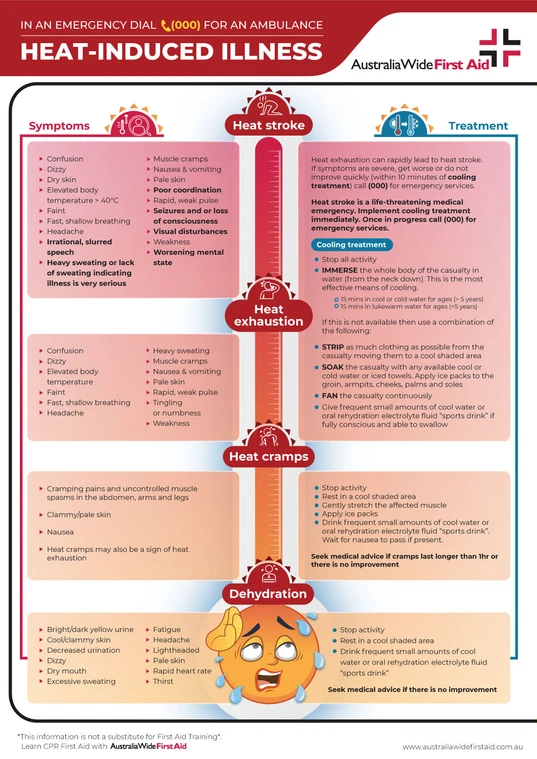
Heat-Induced illnesses are coming among hikers, as hikers can become dehydrated while overexerting themselves in hot and humid conditions.
Safety in the Heat
Consider if you will, going for a hike… a walk in the woods. But before setting off, try this quick quiz:What’s the difference between Heat Exhaustion and Heat Stroke?
Here's a couple of hints: both fall under the umbrella of hyperthermia, a condition that occurs when a person's body generates more heat than it can release, and both typically present in casualties who are dehydrated or who overexert themselves in hot and humid conditions. The answer: heat exhaustion is considered a milder form of hyperthermia, while heat stroke is considered the most severe. Heat exhaustion can be characterised by muscle cramps, as well as headaches, fatigue, nausea, and profuse sweating if associated with exertion. To mitigate the effects of heat exhaustion: rest the casualty in the shade; remove any of their excess clothing; sponge them with water; and, give them sips of water or electrolyte drink once any nausea has passed. More information about how to identity and manage heat exhaustion can be found in our Resource Library. If heat exhaustion is not correctly addressed, it could quickly develop into the more serious of the two heat-related illnesses — Heat Stroke. Heat Stroke is a potentially fatal condition that occurs when the body's temperature escalates beyond 40° C. When a person is suffering heat stroke, their skin will be dry, their pupils will appear concentrated, and their breathing will be rapid and shallow. They might also experience severe thirst, confusion, nausea, and muscle cramps. To treat a person suffering from heat stroke, apply first aid cooling techniques and call Triple Zero (000) for emergency services, per our article on heat stroke first aid. If the casualty stops breathing normally at any point, commence DRSABCD and be prepared to perform CPR. Head to our Resource Library for more information about performing CPR.Important Notes on Heat-Induced Illness
Severe dehydration can have serious consequences for children under 2, elderly people, diabetic people, and those with kidney, heart, or circulation problems. In such cases, it’s best the casualty is taken to hospital immediately. Prevention is the best cure for Heat-Induced Illnesses…- Don’t leave the kids (or your pets) in the car.
- Drink plenty of water, rather than tea, coffee or alcoholic beverages.
- Wear lightweight, loose-fitting clothing made from fabric that "breathes" and allows sweat to evaporate.
- Protect yourself outside — ‘Slip, Slop. Slap. Seek, Slide’.
- Where possible, do outdoor chores before 10am and after 4pm. Otherwise, limit the time you spend doing those chores.
- Keep your energy levels up by eating nutritious foods, including plenty of fruit and vegetables.
Paralysis Ticks
Paralysis ticks usually inflict themselves on unsuspecting animals - native Australian species, mainly. However, they are also a sucker for any livestock, domestic pets, and humans that cross their path. Tick prevention is just as important for humans as it is for animals, as many of us experience allergic reactions from ticks. Reactions range from mild itching and localised swelling to life-threatening anaphylaxis. Although paralysis ticks can be found all year round, the peak season is Spring and Summer, when warm weather combines with periods of rain. Paralysis ticks are generally prevalent in moist, humid environments, and they are especially common in wet forests and temperate rainforests, where they hide among trees, logs, leafy debris, and uncontrolled vegetation. Avoiding ticks is the best way to reduce your risk of experiencing an allergic reaction from a tick bite:- Walk in the centre of trails and avoid walking through dense vegetation
- Tuck your pants into your socks and your shirt into your pants so ticks have less direct skin contact
- Wear light coloured clothing as ticks will be much easier to detect
- Wear insect repellent containing at least 20% DEET. It can protect you from ticks for several hours. Apply it to the skin before going into likely tick territory.
Spiders
We have some 2900 species of spiders in Australia… a reasonable excuse for arachnophobia. Among the more frightening of them is the Huntsman. They don’t often bite and their venom isn’t considered dangerous to humans. But they sure do scare the heck out of people. It’s all the ensuing flight response accidents that are the worry. The only spiders responsible for fatalities, in fact, are Funnel-webs and Redbacks. But not any more. Records show we’ve had no deaths from spider bites in Australia since 1981. Since anti-venoms were introduced for both these species, deaths have been curtailed. Below is some information about Funnel-webs and Redbacks:- Funnel-web spider: The Sydney Funnel-web can be found in many urban and natural locations throughout New South Wales. They are typically aggressive when threatened, and their large fangs can deliver a deep injection of altracotoxin. First aid for a Funnel-web spider bite can be found in our article on Spider Bites in Australia.
- Redback spider: Redback spiders can be found throughout Australia, particularly in dry, sheltered places close to human habitats. They are nocturnal and only females bite when threatened. First aid for a Redback spider bite can be found in our article on Spider Bites in Australia.
- Mouse Spider: Mouse spiders are lethargic, relatively non-aggressive spiders found across Australia in burrows and near waterways. Their most distinctive feature is a bulbous head and jaw. The treatment for a Mouse spider bite is the same as that of a Redback spider bite.
- Trapdoor Spider: Trap-door spiders are found throughout Australia in natural and urban environments. They are aggressive when threatened and, like the Funnel-web spider, their bites can cause localised pain and malaise. As such, the two bites are treated the same.
- White-tailed Spider: Though they can be found throughout Australia in natural and urban environments, the White-tailed spider likes coastal areas. They have a whitish tip at the end of their abdomen. Their bites can cause mild localised pain and are treated in the same way as a Redback spider bite.
- Australian Tarantula Spider: Australian tarantulas typically prey on insects and small reptiles and amphibians. Though their bite typically only causes pain in humans, it can be fatal to dogs. Their bites should be treated in the same way as a Redback spider bite.
- Recluse Spider: Recluse spiders are generally distributed in South Australia. Their venom can be haemotoxic and cause damage to the skin and blood. It should be treated in the same way as Redback spider venom.
- Golden Orb Spider Garden Orb spiders are common throughout Australia and are mostly active at night. They are highly aggressive and likely to bite when disturbed. The treatment for a Garden Orb spider bite is the same as that of a Redback spider bite.
- Difficulty breathing
- Wheezing
- Rashes or hives
- Stomach cramps
- Itchiness
- Swelling of the mouth, throat, and face
Australian Snakes
Australia has around 100 venomous snakes, 12 of them with bites that can kill. Snake bite is more than a little challenging because it’s often difficult to distinguish the snake species and determine whether the bite is going to be life threatening. Symptoms of venomous snake bite include:- Paralysis
- Nausea
- Convulsions
- Pain & swelling
- Brown Snakes
- Copperhead Snakes
- Death Adders
- Taipans
- Tiger Snakes
- Some Sea Snakes
- Dry Snake Bites: This occurs when a snake strikes a casualty but does not release any venom. The bite, however, can still puncture the skin and cause localised pain and swelling. While this type of snake bite would generally not require anti-venom, Triple Zero (000) should still be called in case the casualty begins experiencing complications like anaphylaxis.
- Venomous Snake Bites: Unlike a dry bite, a venomous snake bite occurs when a snake strikes a casualty and releases venom. The venom released by a snake bite contains poisons that are intended to numb, stun, or even kill other creatures. The symptoms of a venomous snake bite include blood or bite marks at the wound site, blurred vision, difficulty breathing, and nausea. More symptoms can be found in our article on identifying and treating snake bites.
Conclusion
The Australia Bush is beautiful and wild. It needs to be treated with respect. If you plan to enjoy it fully, you simply need to go with your wits about you. This article has gone into detail about some of the most serious concerns, major catastrophes aside. And it shows that, with a little preparation, a decent first aid kit and some fair dinkum training in first aid, you can set off with the bush skills to more confidently see the Great Outdoors and live to talk about it. There’s no time like right now if you want to do something about first aid training for yourself or your fellow adventurers. Head on over to our FAQ page now to learn more about signing up to one of our streamlined first aid courses.
Originally published at
https://www.australiawidefirstaid.com.au/resources/a-guide-to-safer-hiking-in-australia
as part of the Australia Wide First Aid Articles Library


